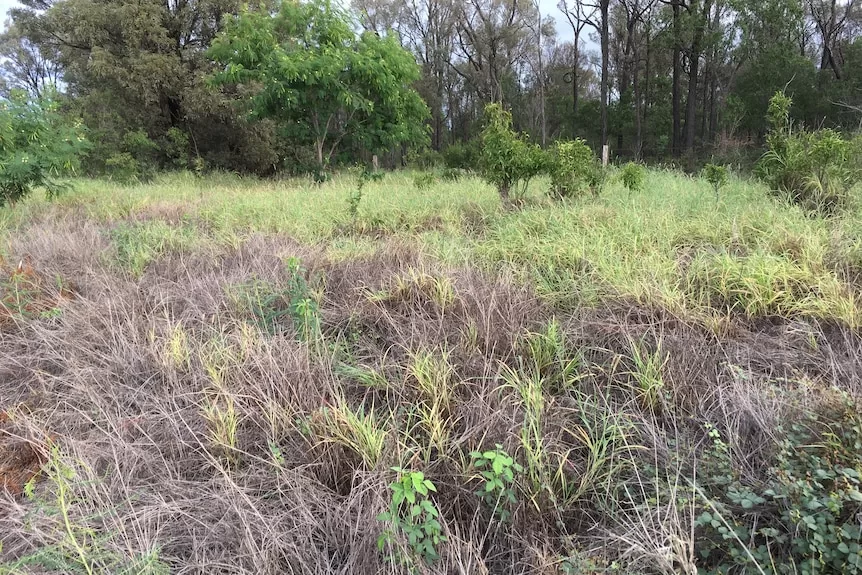There is new hope for graziers despite devastating pasture dieback costing graziers billions spreading west to previously unaffected Queensland cattle country.
First identified in the Sunshine Coast hinterland in 1928, invasive populations of the tiny sap-sucking mealybug Heliococcus summervillei re-emerged in 2015 and have exploded after months of wet, warm conditions.
Now accepted as the primary cause of pasture dieback, the intrepid insect can hitch a ride hundreds of kilometres through the air with storm fronts.
Pesticides are useless against the mealybugs’ ability to tunnel through the earth and survive winter up to 900 millimetres underground before emerging to disintegrate widening patches of susceptible pasture.
Newly impacted regions include Charleville, Chinchilla, Goondiwindi, Inglewood, Injune, Millmerran, Roma and St George in Southern Queensland.
Also affected are Alpha, Jericho, Springsure and Tambo in central Queensland, and land near Charters Towers, Cloncurry and Lakeland in north Queensland.
Western invasion
Queensland Department of Agriculture and Fisheries (QDAF) principal agronomist and pasture dieback lead Stuart Buck said what was new in the past six to12 months was that the mealybugs were spreading into drier locations.
“In the past we’ve thought that it might not get out that far because the rainfall was a bit lower,” he said.
“Maybe these little mealybugs have already been out there and just sort of poking around until the right environmental conditions came along for them to really explode in numbers.”
Loading…
Vital feed lost
In 2019 Meat and Livestock Australia estimated the cost of pasture dieback exceeded $2 billion in lost productivity.
Graziers calculate “forage budgets” to determine the number of cattle that their land can sustainably carry, and pasture dieback is like stocking a fridge full of food, only to have it rot before your eyes.
What starts as leaf discolouration turns into dead patches which are then colonised by broadleaf weeds or legumes that are unaffected by pasture dieback.
“For people who have severe dieback, it’s devastating to their pasture production and their feed supply for their cattle,” QDAF principal agronomist Gavin Peck said.
“Fortunately it hasn’t been whole districts, but that’s small comfort for people who are badly affected because, at the property scale, it can wipe out a significant percentage of people’s pastures.”
New hope
However, in once-dead patches of research fields, scientists are proving there can be life after mealybug infestations.
“We’re getting really amazing and encouraging results,” Applied Horticultural Research plant pathologist Naomi Diplock said.
“I think there’s real promise for using some more tolerant grass species and being able to produce feed in dieback-affected country. It’s really exciting the results that we’re seeing.”
For three years Dr Diplock has been part of a research effort investigating management options for mealybugs that suppress the immune system of grasses, allowing other plant pathogens to move in.
“We can’t control the mealybug at this point so we’ve been looking at ways that we can still produce pasture in dieback-affected areas,” Dr Diplock said.
Dieback resistance
In a study at Gaeta in the Bundaberg region, 14 different varieties of pasture grasses were assessed for their suitability and susceptibility to pasture dieback.
They found that bisset bluegrass was significantly affected by a high number of mealybugs compared to other varieties.
While rhodes grass appeared to be impacted by some dieback, it was less susceptible than bluegrass.
Endura rhodes, mekong brizantha, purple pigeon and tully grass all showed good ground cover despite the mealybugs’ presence.
“Mekong has been showing it doesn’t host mealybugs so is resistant to dieback, but needs to be grazed and managed well to keep it viable as a grass … not letting it get too tall,” Dr Diplock said.
She said legumes were not susceptible to dieback and helped improve soil health and pasture resilience.
“Replanting with a simple grass and legume mix, or in situations where you can’t plant legumes because of weeds, just a simple grass mix using more tolerant species, is giving us really fantastic results.”
The Queensland government is urging people to report outbreaks using its free pasture dieback app.
Across the region where Heliococcus summervillei was first discovered, members of the Gympie Beef Group have been concentrating on improving soil and pasture health.
President Jim Viner said members had been seeing more widespread dieback this year.
“Driving around, one week a paddock is looking fine and a couple of weeks later the whole paddock has gone and I feel sorry for those people,” he said.
In New South Wales, pasture dieback was first identified in 2020 in the Tweed Valley and has since spread south to the Grafton region and west to the Tabulam district.
Stories from farms and country towns across Australia, delivered each Friday.
